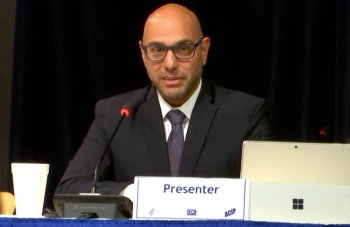
What Obamacare market exits mean for physician practices
What payers ditching plans means for your practice-and why finding solutions for handling collections has become vital.
With Aetna becoming t
More policy coverage:
Even after insurers cover their portion of the charges, patients must pick up the rest. And when bills go unpaid, this means
Asking for money while trying to maintain patient trust is no easy task. However, it’s one that physicians can’t ignore if they intend to stay in business. “Some practices feel that money and medicine don’t mix, but you also have a financial obligation to keep your business running,” says consultant Elizabeth Woodcock, MBA, CPC.
Last month, Aetna announced amid $430 million in losses from its participation in Obamacare dating back to 2014, it would stop selling plans in 11 states. The payer joins UnitedHealth and Humana in abandoning Obamacare citing millions in losses and mounting skepticism about how the marketplace operates.
A recent study by the Kaiser Family Foundation on marketplace premiums predicts a 9% rise in average plans (those with the lowest cost “silver” plans), to an average $281 in monthly premiums. The same study finds that patients in states like Tennessee (27%) and Oregon (26%), as well as Washington, D.C. (21%) will see much steeper monthly increases.
The reality is that many patients may not be able to afford their medical bills. A recent report issued by the Consumer Financial Protection Bureau (CFPB) found that medical debt accounts for 52% of the debt collection actions that appear on consumer credit reports.
Hot topic:
In addition, only 48% of Americans would be able to completely cover emergency expenses-including medical expenses-exceeding $400 without having to sell something or borrow money, according to the Federal Reserve’s most recent report on the economic well-being of U.S. households.
Rising healthcare costs have forced many physicians to contract with-and rely on-a collection agency simply to stay in business. Woodcock estimates that 20% to 30% of revenue for a typical medical practice comes directly from patients-making it worthwhile to partner with a trusted agency.
“Collecting money from patients is a struggle, but it’s also a necessity,” she says. “If you’ve done a good job making the attempts to collect, then really at that point, these are patients who deserve to get that phone call.”
Although some practices may choose to take the loss and write off any unpaid patient balances, many physicians have begun turning to collection agencies to pursue the revenue. But at a time when patient engagement and positive outcomes are increasingly tied to reimbursement, physicians need to tread carefully.
Consider Arkansas-based solo primary care practitioner Mark Miller, MD, who sees 180 patients weekly with the help of one nurse practitioner and one physician assistant. He has used a collection agency since opening his practice a decade ago.
Further analysis:
Miller sends overdue accounts to the agency only when patients are no longer active. For active patients with unpaid accounts, staff members follow up directly either via phone or in person during the patient’s next visit. The clinic generally sends three statements and follows up with a phone call before referring an account to collections.
Miller also personally reviews each case before sending it to the agency-just to be sure that the approach will yield a return on investment. For example, if a patient is experiencing financial hardship due to a recent job loss, he may write off the copayment or co-insurance for a particular visit.
“As a primary care doctor, I’m involved in patients’ lives, and I know their situations. This is one of the benefits of being a small practice. We can make decisions locally,” he says. “I have the discretion to mark somebody off that list.”
Related:
The rising tide of healthcare costs doesn’t seem to be subsiding any time soon. The average annual deductible for individuals covered under employer-sponsored health plans has grown an astonishing 67% in the last five years-from an average of $646 to $1,077, according to a report by the Henry J. Kaiser Family Foundation. Even once the deductible is met, 68% of these individuals reported that they must pay a copayment for office visits with a primary care physician or specialist.
For plans sold on health insurance exchanges, deductibles are even higher. In 2015, silver plans with a combined medical/prescription drug deductible had an average deductible of $2,563, according to another Kaiser report. In silver plans with separate medical and drug deductibles, the average annual medical deductible was $3,456. For bronze plans, the average annual deductible exceeded $5,300.
Robert Lee, MD, a primary care physician in a large multi-specialty group in Johnson, Iowa, and former owner of an independent four-physician practice, has always worked with a collection agency. “If patients don’t respond by the third letter, we know that they probably don’t have any interest in responding,” he says.
The third letter not only notifies patients that their account will be sent to a collection agency, but tells them that their relationship with the practice will be terminated after 30 days if the balance remains unpaid. The practice recommends that the patient use this time to seek and establish care elsewhere.
However, collection agencies are not always the answer, he says. “Most of us didn’t go into medicine because we wanted to make money. We went into medicine because we wanted to do good. We would much rather write off something than have a patient skip medical care because they didn’t think they could afford it. Patients at my current practice treat us really well because of that.”
More Health Law & Policy coverage:
When Lee owned his own practice, he didn’t send every unpaid account to collections. If patients tried to pay a portion of the bill or set up a payment plan, Lee was willing to work with them. “We literally had patients who paid $10 a month,” he recalls.
Collection agencies: Weighing the pros and cons
Collection agencies not only help physicians gain monies owed, they can also improve operational efficiencies by allowing internal staff members to focus on other tasks, says Richard L. Gundling, FHFMA, CMA, vice president of healthcare financial practices at the Healthcare Financial Management Association (HFMA). HFMA and the Association of Credit and Collections Professionals have published a report titled Best Practices for Resolution of Medical Accounts that helps physicians develop a process for resolving the patient portion of medical bills.
However, there are also potential drawbacks. The most obvious disadvantage of working with a collection agency is that the practice loses some of the money it’s owed. For example, the agency Miller uses takes a 30% cut of the payments it recovers. Lee says the agency with which he works charges a standard fee per account plus 50% of the money recovered.
There are also operational challenges. For example, without integration between practice management and collection agency software, practices must submit accounts manually, says Woodcock. “Because it’s a manual process, it often doesn’t get done with regularity, and because it’s not within a routine workflow, I find that it sometimes gets left out altogether,” she adds.
Further reading:
The negative connotations associated with collection agencies is another potential disadvantage. This association can put a strain on patient relations, says Miller. Luckily, he hasn’t received any negative feedback regarding the agency his clinic uses. “It’s probably because people are embarrassed that they owe us the money and don’t want to talk to us about it. Most of the time, those are the patients that aren’t coming back to us to re-establish care,” he adds.
Legal, public relation concerns persist
Even so, every collection agency should follow good patient relations practices regardless of a patient’s status, says Gundling. “The patient sees the collection agency as an extension of their primary care physician,” he says. “If the agency is more aggressive than the physician wants them to be, it can be detrimental to the practice’s public relations.”
Depending on the relationship between the agency and the physician, aggressive collection tactics can even raise legal concerns, says Robert N. Pelier, JD, general counsel at Gables Insurance Recovery, a company that helps physicians recover payment from insurance companies and patients.
Sometimes the collection agency works directly on behalf of the provider-rather than as an independent third party, says Pelier. “Certainly if the collections agency is not professional and fails to adhere to federal and state guidelines, this certainly exposes the provider,” he says. For example, if a patient feels harassed, he or she could have legal grounds to sue the physician.
On the other hand, if a provider actually sells the unpaid claims to the agency-and settles for a flat amount-then the transfer of those claims essentially absolves him or her from any legal consequences. The agency essentially owns all legal rights to pursue funds completely independent of the physician, Pelier says.
ICYMI:
According to the Federal Trade Commission, patients may have the right to sue the physician when the collector operating on the physician’s behalf violates the Fair Debt Collection Practices Act-the federal guideline that prohibits debt collectors from using abusive, unfair, or deceptive practices. These types of lawsuits don’t occur frequently simply because patients aren’t aware of their rights under the guideline, says Pelier. However, if patient sues the provider-and wins-he or she can require the physician to pay for any damages suffered as a result of the illegal collection practices (e.g., lost wages and medical bills).
Even if the patient can’t prove that he or she suffered actual damages, the physician may still be required to pay up to $1,000 along with attorneys’ fees and court costs. Patients also may sue a physician as part of a class action lawsuit and recover money for damages up to $500,000, or 1% of the physician’s net worth, whichever amount is lower.
Each state has its own laws regarding whether and how patients can contest collection efforts, and Pelier advices physicians to seek legal counsel, if necessary.
Related:
Some physicians just don’t want the potential legal headaches associated with collection agencies, says Gundling. Others don’t contract with an agency simply because they’re not comfortable asking for money. “Some healthcare professionals are reluctant because they don’t want patients to think that money was getting in the way of their care,” he says.
Newsletter
Stay informed and empowered with Medical Economics enewsletter, delivering expert insights, financial strategies, practice management tips and technology trends — tailored for today’s physicians.
















